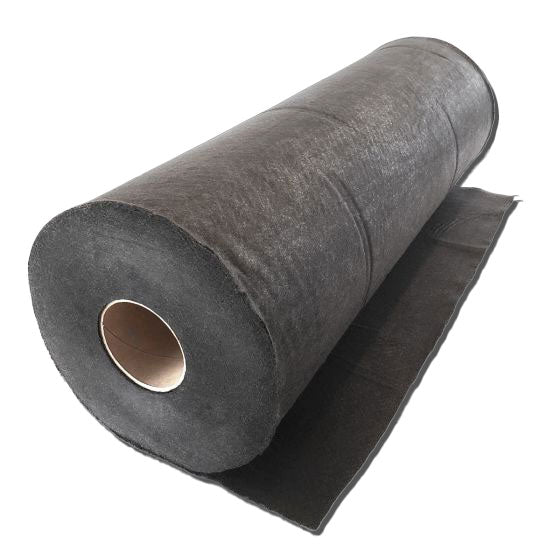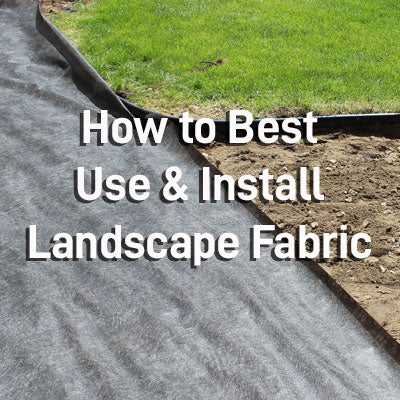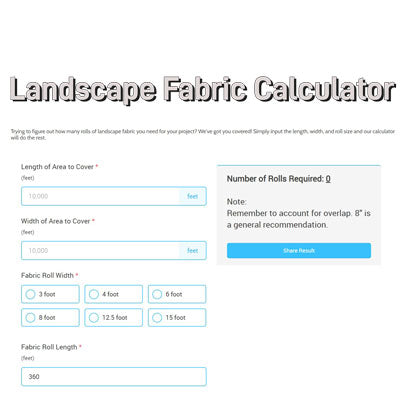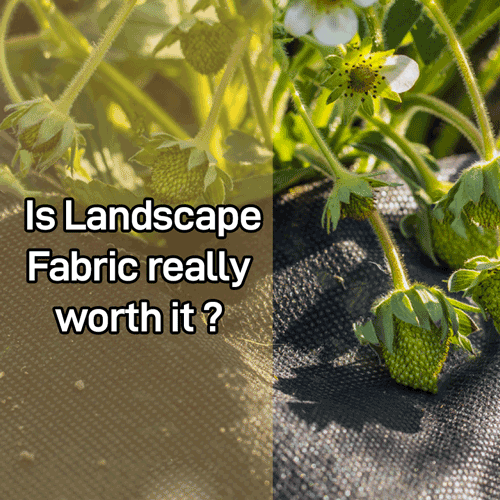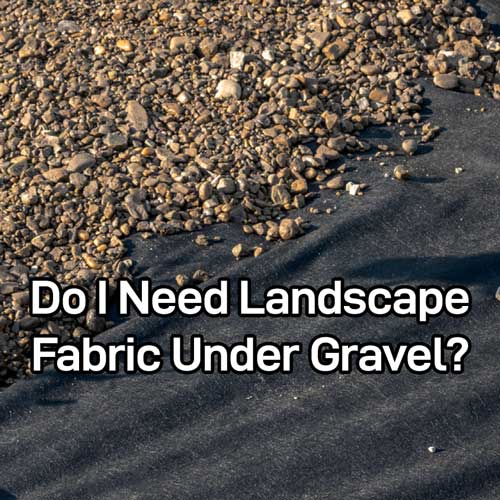March 18th, 2022
Pro Fabric Supply - Phone (800) 520-7731
Email: support@ profabricsupply.com
Everything you Need to Know About Using and Installing Landscape Fabric

Landscape Fabric installed in garden beds
Landscape fabric is this thin layer of fabric that is placed above the soil, and below mulch, sand, rock, asphalt, or other aggregates. The use of this fabric can be of great benefit to a garden, soil stabilization, or road construction project. There are many benefits of landscape fabric, but its main purposes are to separate soil, stabilize, drain, and filter water or runoff.
The following are the most popular uses for Landscape Fabric:
- Weed Barrier
- Yard Drainage – French Drains
- Drain fields
- Erosion Control
- Driveway & Path Stabilization
Landscape fabric is a great asset to gardens for several reasons. Here are the most popular uses of landscape fabric and how to install it.
How to Install Landscape Fabric
Now that you know what a great option landscape fabric is, you're ready to install. Before you commit to installing landscape fabric, check out the steps below to see if it's something you're confident doing on your own.
Before you start, you’ll need to gather these supplies:
- Landscape fabric
- Plant food and/or fertilizer
- Shovel, garden rake, or tamper
- Ground staples
- Scissors or shears
- Rocks, pebbles, or mulch
Here's what to do:
- Layout food and fertilizer
- Grade the ground
- Layout the landscape fabric
- Cut to size
- Stake the landscape fabric down
- Lay down mulch or rock
Lay Out Food And Fertilizer:
All that is necessary for this step is to take any soil or food to grow the plants in and create a landscape for it. It is very important to complete this task first as the landscape fabric will go above the soil.
In most cases, it is very beneficial to the garden to dig down about two or three inches and surround the perimeter of the garden with a 2X4. This will keep the area in which the fertilizer is laid down in place.

Grade the Ground
even out the area, it is all level. Smoothing the ground can be done by flipping to the backside of a gardening rake and gently grazing over the entire area. A smooth surface is going to ensure that the garden contains no unwanted mounds.
Lay Out Landscape Fabric:
This step is to roll out the roll of fabric and lay it across the entirety of the garden. It is essential that you layout an area bigger than what your garden is set out to be. Don't worry. You'll measure the fabric and cut to size in the next step.
Tip: To help keep your plants healthy year round use our freeze cloth for plants.
Cut to Size:
Once the fabric is all laid out, cut the excess to create the exact size that your garden will be.
This is also a good time to cut some holes into the plants' fabric to come through.
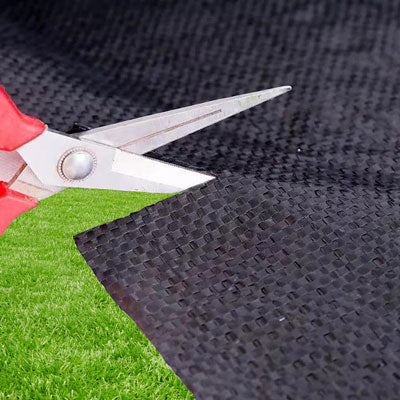
Stake the Landscape Fabric Down:
To keep the fabric in place, it is a good idea to use stakes or gardening staples to hold it down. All you have to do is hammer them into the ground every four or five inches, and then the landscape fabric will remain in place.

Lay Down the Mulch:
The final step in installing landscape fabric is to cover it all up with the mulch. It is a good idea to stamp some down near each plant's base within the confined space. The mulch will create a strong foundation for the plant. Aside from that, there needs to be about a couple of inches of mulch laid down to cover the entire landscape fabric.
Once the landscape fabric is covered, the garden is complete. Before getting started, it is important to know the different kinds of landscape fabric and which one will be best for your specific situation.
The following are the most popular uses for Landscape Fabric:
1. Weed Barrier - Landscape Fabric Prevents Deep Weeds from Growing
Landscaping fabric won't prevent all weeds from growing, contrary to popular belief. When people find out that this is not the case, they seem to grow disappointed with the product. But, landscape fabric will keep deep-rooted weeds from growing.
It must be understood that when using landscape fabric that weeds are still going to grow. What landscape fabric is designed to prevent is deep weeds. To explain, the way that this fabric is installed is to be above the soil and below the mulch.
Since the fabric is below the mulch, it will not prevent the growth of weeds in the mulch. The weeds are going to be prevented in the soil where they are deeply rooted. Using landscape fabric will take away from backbreaking weeding every few days. And sometimes, those extra deep weeds take more than just pulling. Some require digging and even more hard work.
When the weeds aren't deeply rooted, they are mostly effortless to remove from the mulch. If you let the weeds grow for a bit, they will not penetrate the weed prevention fabric, and they will be easy to pull with the as the roots will not be deep.
What this is to say is that the landscape fabric is not going to prevent weeds from ever-growing. It is meant to make the weeding process quicker and easier.
2. Yard Drainage – French Drain Fabric
One of the most popular uses of nonwoven landscape fabric is for lining French drains. A French drain is used to move water away from a pooling area by providing space for water to flow.
A typical French Drain has 3 components:
- Nonwoven Landscape Fabric
- Perforated or Slotted Drainpipe
- Clean Round Rock
The process for installation after you’ve dug your trench is very easy. First, you will line the trench with a 4-6oz non-woven fabric so that you will be able to wrap both the drainage rock and pipe after they’ve been placed in your trench.
After French Drain Fabric is placed in the trench then you’ll lay the perforated or slotted drain pipe. The pipe size is dependent on the amount of water flow is needed, but typically a 6” drainpipe works well for many residential applications.
Following the drain pipe 1-1/4” clean round rock is placed over the pipe. Larger round rock is crucial to enable enough void space for water to flow between the rocks and enter the drain pipe.
Pro Tip: Do NOT use crushed rock for drainage. Crushed rock also known as crusher run or minus will clog the pipe and does not enable water to easily flow.
To read more on the subject of French Drain Installation check out the article:
The 7 Common French Drain Mistakes and How to Avoid Them
French Drain Fabric - 4oz - 6' x 100' Roll
French Drain Fabric is the ideal product for lining drainage trenches. This sturdy nonwoven fabric is placed in the trench before drain-pipe and drain-rock to increase the life of the drain and filters out debris from the groundwater.
The french drain geotextile fabric is high-flow enabling water to pass through while preventing dirt and other sediments from clogging up your drainpipe.
3. Drain Fields separation fabric
Drain fields are instances where landscape fabric provides a separation layer between soils, typically between sand from the drainage system below and dirt above. A common drain field that you might encounter is a septic drain field.
When the weeds aren't deeply rooted, they are mostly effortless to remove from the mulch. If you let the weeds grow for a while, they will not penetrate the landscape fabric, so there is no chance of getting deeply rooted weeds even if they are left to grow for a while.

Diagram of a separate drain field. Fabric separates gravel from sandy loam soil.
4. Provide Erosion Control with Landscape Fabric
Landscape fabric can essentially work as a barrier. When there is a mulch supporting a garden, heavy rain can make the soil beneath the mulch start to wash out. When there is landscape fabric installed under the mulch, it acts as a molding for the soil.
Since that molding figure is present, the soil will experience a significantly lower rate of washout. Avoiding washout is essential since the soil will have nowhere else to go when it flows away.
Erosion control is important because it keeps your garden in shape. Without erosion control, there is the possibility that a garden can start to wear away due to runoff. Excess runoff leaves the garden looking out of shape.
5. Landscape Fabric for Driveway and Road construction
Erosion control is important because it keeps your garden in shape. Without erosion control, there is the possibility that a garden can start to wear away due to runoff. Excess runoff leaves the garden looking out of shape.

It’s important to keep the layers of gravel and soil separate as the gravel will mix down into the dirt below and form potholes that will constantly need to be repaired and filled in over time. By laying driveway fabric before you place your gravel for a road or driveway you can save money and a lot of time having to repair and refresh the gravel.
Take a look here at the full Driveway Fabric Installation guide here:
https://www.profabricsupply.com/pages/installing-driveway-fabric-a-helpful-illustrated-guide
6. Landscape Fabric Works Under Rocks and Pavers, Too
If you’re planning on laying a path of pavers or covering an area with gravel, putting a weed barrier under gravel is an excellent first step in the process. Laying down landscape fabric will help prevent unsightly weeds from popping up in between the rocks and pavers, and as you probably already know, these are a pain to get rid of.
Landscape stabilization fabric is also an effective way to stabilize the soil before laying down a patio or other hard surface. Once the soil’s been graded and put into place, it’s essential to keep it from shifting, otherwise, you’ll need to repeat the process.
Applying landscape fabric can help avoid having to do any extra work. Sure, it’s an additional step in creating your hardscape, but in the long run, it’s an effective one.
In some areas, gravel and pebbles are a better alternative to mulch. If this is the case, then landscape fabric is a fantastic option to put down after planting, but before adding the rocks.
Take a look here at the full Driveway Fabric Installation guide here:
7 Reasons Why Professionals Always Use Landscape Fabric Under Gravel
BENEFITS OF USING LANDSCAPE FABRIC
Keep the Soil Moist with Landscape Fabric
The moisture content in soil is an important measure of a healthy growing medium. Soil is where the roots get their nutrients, and moisture is key to moving this process along.
This fabric layer will act as a barrier to the sun, reducing the amount of evaporation possible. There will still be a level of evaporation taking place so that soil does not become saturated, but there will also be a healthy amount of moisture left behind.
When the soil remains moist, plants will grow healthier and more rapidly. Moisture in the soil even makes the growing process easier in the sense that it requires less attention. Watering will not be needed as frequently since water is already present in the soil.
Avoid Chemicals with Landscape Fabric
It was mentioned earlier that landscape fabric is the way to prevent deeply rooted weeds without chemicals. Staying weed free without having to use chemicals makes the use of landscape fabric more environmentally friendly.
The use of chemicals on weeds can be hazardous for a couple of reasons. For instance, a weed killer with a spray delivery method will often soak into roots that are not meant to be killed. Chemicals can also lead to having plants that are a part of the garden dying. Accidentally killing other plants is also partially linked back to inaccurate spraying, which is common, especially on windy days.
Secondly, excessive use of chemicals on plants may cause contamination in the ground. When there is a rainstorm while the ground is contaminated, water runoff will become saturated with this chemical. When the runoff leads into areas of local water supply, all living organisms can be affected.
The use of landscape fabric cancels out all these possibilities simply because no chemicals are being absorbed into the ground.
Frost Blankets
A Frost Blanket helps lengthen the harvest time and flowering season by keeping the air warmer underneath it than above it. This fabric is available in various roll sizes.
Landscape Fabric Can Help with Settling
Over time, sediments like rocks have the potential to sink into the soil. Settling can be hazardous to the plants that are in the garden. The problem with rocks in the soil is that they can raise the overall temperature of the soil.
Settling will essentially lead to dehydrating the plants that are in the soil. When the plants grow to be dehydrated, they need constant attention. If this attention is not given daily, perhaps even multiple times a day, the plants will die.
Landscape fabric will prevent these rocks from getting packed down into the soil. Rocks aren't able to get into the soil because of its thickness. Rocks may travel under the mulch, which is no threat to the plants, but the rocks will always be stopped once they reach the landscape fabric.
Landscape Fabric is a Cost-Effective Option
A piece of good landscape fabric will last for many effective years in a garden. Years of effectiveness is great because there will not be upkeep in purchases for landscape fabric. All you have to do is buy it once, and it will last for some years, depending on the brand and type of landscape fabric used. In the winter you use our frost cloth for trees to help improve the health of your crop.
Another underlying purchase that will no longer have to be purchased is the weed killer. Since the use of landscape fabric makes it so that there is no need for a weed killer, another expense can be crossed off the list. Using landscape fabric will result in less money spent on the garden in the long run.
Landscape Fabric is Better Than Plastic
Some believe that landscape fabric and plastic (sometimes called a weed tarp) can do the same thing. There is, however, one key difference that makes landscape fabric more effective than plastic.
Landscape fabric strategically contains small pores that allow water to reach plant roots. Plastic does not contain these pores, making it so that water can only make it through the plastic in the holes made for plants. The holes in landscape fabric make it so that significantly less water is being absorbed into the soil.
With landscape fabric, the entire roll is full of pores. This makes it so that areas that are not even holding a plant can still absorb water. It makes the entirety of the soil base moist, which in turn makes great bedding for plants.
Landscape Fabric Provides Temperature Control
As mentioned earlier, the landscape fabric acts as a sun blocker. In the winter placing our frost cloth over your plants and trees will increase their harvest time as well as keep them healthier by allowing air to pass through while increasing the temperature under the frost cloth.
Temperature control is also enhanced because there is less evaporation that takes place under the landscape fabric. The increased moisture in the soil prevents the temperature from rising too high for the plants.
Although there are plants that can do like a lot of sunshine, the roots are under the ground for a reason- they can’t take the heat. Wholesale row covers can help regulate the underground temperature, which keeps the roots happy. Happy roots make happy plants.
Landscape Fabric is Easy to Use
Unlike most other landscaping installations, landscape fabric is very simple to install into a garden. Easy install adds to the cost-effectiveness of landscape fabric because there is no need to hire a professional in most cases. Just about anyone can do this.
The entire process of landscape fabric installation can be done in just a couple of hours. One of the best things about it is that you do not need to remove weeds present in the soil you wish to cover. The reason behind this is the fact that all sunlight is going to be blocked from these plants. Within a few days of installation, all weeds that are covered by the landscape fabric will die.
The simple and straightforward install is great because it takes the potential backbreaking hours out of the process of installation. Then, once the installation is completed, there is no upkeep of the landscape fabric. Depending on the quality of the fabric laid down, the fabric can remain untouched for up to fifteen years.
While landscape fabric is simple to install, all steps must be followed. If some of the steps are not followed, then it is possible that weeds can make their way through or come up around the edges. This can also lead to the damaged fabric, which will then have you replacing the landscape fabric much earlier than anticipated.
Bottom Line
Landscape fabric is a great way to create beautiful gardens and landscapes. It has many great benefits that will take backbreaking and time-consuming work out of your work. Landscape fabric is a great asset to have in a garden because they help prevent unwanted weeds from showing up.
Using landscape fabric will also benefit both your pockets as well as the environment. Without the constant use of weed killers, you will not have to keep up with purchasing weed killers.
After buying your desired amount of landscape fabric, there will be no further purchases that need to be made until it is time to replace that fabric. Regarding the environment, the decrease in the use of chemicals in the ground is always good for the environment because this prevents the possibility of water contamination caused by chemicals being saturated in the runoff.
Landscape fabric is simple to install. This can help save money because there is no need to hire someone to install the fabric for you. In just a few simple steps, landscape fabric can be installed to make any garden look very pleasing to the eye. All in all, landscape fabric is always going to be a great asset in both gardening and landscaping.
Phone (800) 520-7731
Email: support@profabricsupply.com

